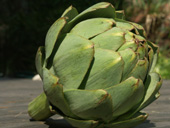
UK/Ireland
•Canada/USA
________________________________________________________________________

eat
artichoke
The artichoke isn't
a food to choose when you need a fast food fix. It's a slow food to linger
over. Patience shown in preparation and eating is ultimately rewarded
by the subtly flavored leaves and the mouthwatering artichoke heart. You
can serve artichoke as a dish in its own right, with a bowl of vinaigrette
or lemon butter for dipping. We prefer to use it as an ingredient, adding
something special to a salad, pasta sauce or pizza topping.
HISTORY
The artichoke developed from the cardoon and is thought to have originated in the Mediterranean region. There are references to it being grown in Italy and Sicily from around 300 B.C. In the ninth century it was being cultivated by the Moors in southern Spain. It is thought to have been introduced to England in the sixteenth century.
Today the artichoke is prized in French and Italian cookery, and recipes for stuffed artichoke have long been popular in Arabic cuisine.
BIOLOGY
A single artichoke is the unopened flower bud of the plant Cynara scolymus, a member of the thistle family.
NUTRITION
The artichoke contains significant levels of vitamin C, folic acid, potassium and fiber.
TIPS
BUYING
Pick artichokes with well-colored, undamaged, tightly-closed leaves. Fresh
artichokes will be heavy for their size due to their moisture content.
Smaller artichokes have more tender leaves (baby artichokes may have leaves
that are entirely edible); larger ones have bigger hearts.
STORING
Sprinkle with a little water and store in a plastic bag in the fridge.
Use as soon as possible for maximum flavor.
PREPARING
Remove and discard the toughest of the outer leaves (bracts).
Snip off any sharp leaf tips. Snap the stalk off at the base and remove
the tough fibers running into the base where possible. Gently prize open
the leaves to gain access to the core of the flower. Pull out the central
cone of thinner leaves to reveal the inedible fibrous 'choke' (this may
not be present in smaller baby artichokes). Carefully scrape this out
with a teaspoon, leaving the prized heart in place. Rinse out the artichoke
with acidulated water (e.g. water with a good squeeze of lemon juice added)
to prevent discoloration.
Iron, copper or aluminum cookware will cause artichokes to oxidize and discolor. Use non-reactive knives and pans (e.g. stainless steel, glass or enamel). Place trimmed artichokes stem end down in a large pot of boiling water to which the juice of half a lemon has been added. It may be useful to place a colander, sieve or other device over the pan to keep the artichokes submerged. Cooking time will be somewhere between 20 and 45 minutes depending on size. Artichokes are cooked when you can easily pull out an inner leaf and the stem is tender. Stand the artichoke stem side up in a sieve to drain and cool. If eating with a dipping sauce, artichoke is best served just warm.
Artichokes can also be grilled or barbecued. Cut in half lengthways, remove the choke, rub with olive oil and grill on a moderate-to-low heat until the base is tender - around 30 minutes.
(Alternatively, if you're using artichoke as an ingredient, open a jar. As a website celebrating fresh seasonal food we shouldn't really be saying this, but there are some highly creditable jars of artichokes available).
EATING
Pull off a leaf, dip (in hollondaise, lemon butter, mayonnaise, or vinaigrette),
scrape the tender portion from the base of each leaf with your teeth and
discard the tougher portion. Repeat until all leaves have been dispatched
(smaller, thinner leaves may be ignored). When you reach the artichoke
heart (cut away the choke if this wasn't done before cooking) eat it with
a knife and fork.
OTHER STUFF
Cynar, an artichoke-based spirit, is a popular aperitif in Italy.
PICK OF THE RECIPES
in
season:
january
february
march
april
may
june
july
august
september
october
november
december
main regions:
California
ONLINE
IN PRINT
-
Globe Artichoke, Pink Grapefruit, Frisee and Pecorino Salad
Happy Days with the Naked Chef

